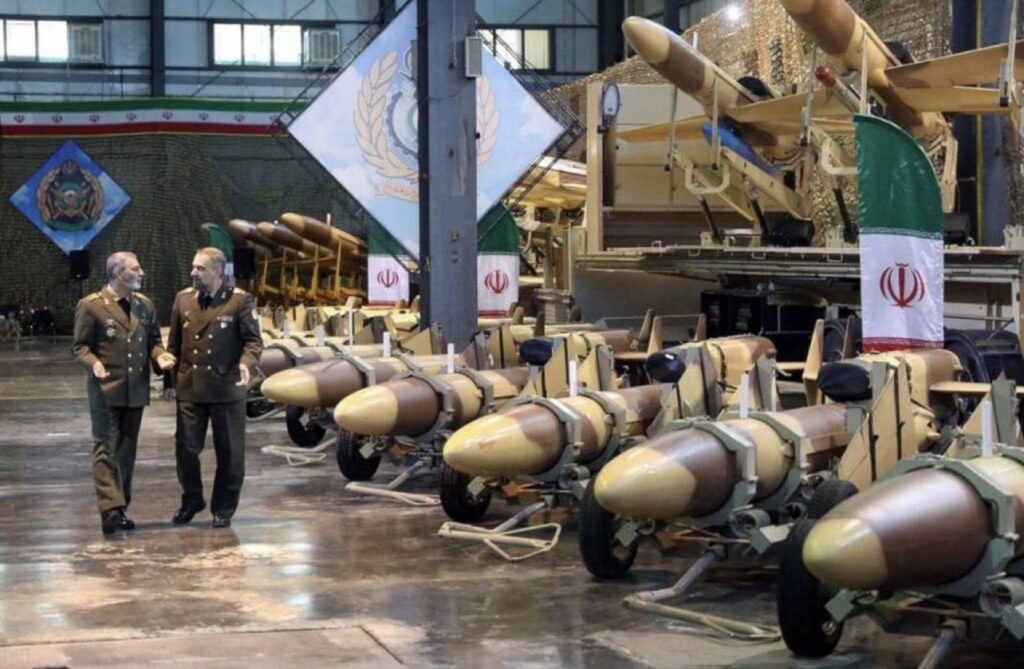Article 2
Arrow Intercepts a Syrian Missile
Technological, Operational, and Political Aspects
BESA Center Perspectives Paper No. 437, April 2, 2017
EXECUTIVE SUMMARY: Israel’s Arrow recently made its combat debut with the interception of a Syrian anti-aircraft missile. Remarkably, the 1991 vintage Arrow missile defense system managed to track, engage, and destroy a type of target never envisaged during its design. This sent a powerful message that Israel’s missile shield is reaching maturity. The political repercussions of the interception raised questions about its advisability, but the repercussions of a non-interception might have been even more severe.

Stages of missile interception by the Arrow system, via Wikipedia
On March 17, 2017, the Israeli public learned that the previous night, the Arrow missile defense system had successfully intercepted a Syrian antiaircraft missile that had been fired against Israel Air Force aircraft engaged in a deep penetration mission inside Syria. This was the operational debut of the Arrow weapon system.
The somewhat laconic announcement by the IDF left unanswered questions. How could Arrow – originally designed to down ballistic missiles – engage an antiaircraft missile? Was the Syrian missile in fact destroyed? Was this an intended interception? What exactly was intercepted? The absence of details was grist to the rumor mill. So was speculation by a leading defense publication that the intercepted weapon was a Syrian SCUD ballistic missile fired in retaliation against the Israeli air attack.
The IDF’s disclosure was also an admission. For the first time since the onset of the Syrian civil war, Israel conceded that its Air Force had attacked targets deep within Syria. All previous reports of such attacks had come from international sources.
The admission raised questions about the wisdom of having intercepted the Syrian missile. Former Prime Minister and Minister of Defense Ehud Barak was quick to comment the next day that, “Upon reflection, perhaps it was not wise to launch an Arrow missile against an antiaircraft missile” because this “forced us to admit the (Israel Air Force) operation in Syria, due to the fall of the Arrow debris in Jordan.” At the same time, Barak said the event “demonstrated our awesome capability.”
The event had immediate political repercussions. Israel’s ambassador in Moscow was summoned by the Russian Ministry of Foreign Affairs to explain Israel’s action. Syria’s ambassador to the UN observed that the Israel’s freedom of action in Syria was no more, and many Israeli commentators agreed. At the same time, Prime Minister Netanyahu declared that all previous agreements with Russia where still in force.
Three days later, the IDF clarified some of Friday’s mysteries. At a press conference, General Zvi Haimovitz, commander of the Israel Air Defense Command, disclosed that Israel’s air and missile defense system had designated the Syrian missile – which he identified as a Syrian SA-5 antiaircraft missile – as a threat that was expected to hit Israel in the central Jordan valley district. “There was no question mark or hesitation” about the need to neutralize this threat, and the decision to intercept was taken “in seconds” by the local commander. Haimovitz’s statements confirmed that this was had not been an “accidental interception” but a deliberate act that neutralized an imminent danger.
The full-scale development of Arrow started in 1991, and the system achieved initial operational capability in late 2000. It is optimized against medium and long range (in Israeli terms) ballistic missiles. The system comprises early warning and fire control “Green Pine” radars, the “Golden Citron” battle management system, launchers, and two types of interceptor missiles: Arrow 2 for high atmosphere interceptions and Arrow 3 for space interceptions.
The system was extensively tested but did not feature in any of the last decade’s wars (the 2006 Lebanon War, Operation Cast Lead in 2009, Operation Pillar of Defense in 2012, and Operation Defensive Shield in 2014). The March 17 interception was thus its first-ever reported combat action.
A video clip recorded from a passing vehicle appears to show that only a single interceptor was launched from somewhere in central Israel. Images released in Jordan the next day showed an object resembling an Arrow missile rocket motor, much damaged by ground impact. From this evidence, it can be deduced that the Arrow system succeeded in destroying a long-range threat arriving from Syria by a single shot – an impressive feat.
But even more impressive is the fact that the destroyed threat was not a ballistic missile but an antiaircraft missile, which was not envisaged as a threat when the system was designed in the early 1990s.
Ballistic and antiaircraft missiles differ in this way: the former are designed to hit stationary targets on the ground, while the latter are designed to hit rapidly moving targets in the air. The disparate missions elicit disparate technical features, not least in their trajectories; hence the difference in the achievability of intercepting them.
While missile defense systems can now be found around the world, no missile defense system dedicated to the interception of antiaircraft missiles has yet been developed. That is because it is more feasible to neutralize them through “soft” defenses like electronic warfare and decoys. The March 17 firing of antiaircraft missiles against IAF planes was not the first such occasion: a previous incident took place in January 2017. In neither case was the Israeli plane hit, indicating that they carried sufficient “soft” defenses to thwart the Syrian missiles.
The air defense system that launched the Syrian missile is dubbed SA-5 by the West and S-200 Vega by Russia. The specific missile used against the IAF was probably the E (for Export) version, which carries a 217 kg warhead.
The S-200 system was developed in the 1960s and became operational in the USSR and among its allies and clients during the 1970s. The system is venerable and by no means ineffective. Its lethality was tragically demonstrated in October 2001 when a Ukrainian SA-5, launched during military exercises, destroyed a Russian airliner over the Black Sea, killing all 78 aboard.
Syria, Iran, and Libya were the Middle Eastern recipients of this weapon. Syria, which received it after the 1982 Lebanon War when its air defenses were largely destroyed by the IAF, was the first country outside the Soviet bloc to possess it. The USSR supplied three batteries that were deployed to permanent bases near Damascus and other priority targets in Syria.
Following the outbreak of the Syrian Civil War in 2011, the SA-5 sites were either abandoned or overrun by insurgents. With the Russian intervention in late 2015, however, a renovation of the Syrian SA-5 batteries was initiated (as conceded by the Russian Minister of Defense in October 2016). The SA-5 battery east of Homs became operational in July 2016, while the SA-5 site in Ghouta, east of Damascus, was retaken from the insurgents three months ago. This explains why no SA-5 missiles were fired at IAF incursions into Syria prior to January 2017.
The SA-5 interceptor is a rather hefty missile. It is initially accelerated by four large, solid rocket boosters, which are discarded three to five seconds after takeoff. Once the boosters are thrown away, the remaining core missile is dimensionally very similar to a SCUD. This core missile is powered by a large liquid propellant rocket motor that accelerates it to 2.5 km per second (nearly eight times the speed of sound).
Western antiaircraft missiles self-destruct automatically if they miss their targets to prevent the falling of live warheads into friendly territory. It is not clear whether the SA-5 has a self-destruct function, and if so, whether it is automatic or is activated by manual command from the ground.
If no self-destruct is activated after a miss, the SA-5 interceptor may well continue its flight in a stable, ballistic trajectory. It will hit the ground at a distance that is determined by its speed and inclination at the moment of rocket motor burnout. At a speed of 2.5 km per second, this distance could be more than 500 km. It stands to reason, though, that the actual range would be shorter, due to the peculiar trajectory and inclination of an antiaircraft missile. Even at a shorter range, the spent missile will be seen by missile defense radars as a ballistic threat.
It appears that what happened in the early hours of Friday, March 17, 2017 was this. An antiaircraft missile fired in a southwesterly direction from one of the renovated Syrian SA-5 sites missed its target, did not self-destruct, and continued to fly in a stable ballistic trajectory towards Israel. It was picked up at a distance by the “Green Pine” radars, its predicted impact point was seen to be within Israeli territory, and it was classified as an imminent threat. The decision to engage it was taken by the local commander as per his orders and the rules of engagement.
The Arrow system functioned properly and engaged the target by a single interceptor that shed its own rocket motor once its fuel was spent, as it was designed to do. The detached motor continued in its own trajectory and hit the ground near the Jordanian city of Irbid. The Arrow then continued its flight and neutralized the threat.
In brief: the Arrow weapons system detected, locked onto, and neutralized a threatening missile of a type never envisaged during its original design. This was a remarkable performance that verified Ehud Barak’s “awesome capability” assessment, and broadcast the powerful message that Israel’s missile shield has reached maturity.
The interception caused a political stir, which prompted Barak to question its wisdom. It must be recalled that the timeframe for decisions by the local commander whether or not to engage is measured in the tens of seconds. This leaves no time for dialogue with superior officers about the engagement’s advisability. The local commander must make a snap decision based on standing orders and established rules of engagement.
Thus, the question of the wisdom of the March 17 decision to engage is irrelevant. Even if, somehow, time had allowed for a more protracted decision-making process, it is not clear that any other decision would have been taken. The impact of a Syrian-fired, heavy SA-5 warhead might have caused damage and casualties in Israel, with consequences no less significant than – and possibly worse than – those actually incurred.
Once the decision to engage had been made, it became impossible to maintain official silence due to the high visibility of the interception and its capture by the video recording devices of civilians, both here and in Jordan. Still, one wonders why it was necessary to include the IAF attack in Syria in Israel’s admission.
Uzi Rubin was founding Director of the Israel Missile Defense Organization, which managed the Arrow program. He is now a senior research associate at the Begin-Sadat Center for Strategic Studies.
BACK TO TOP |
















